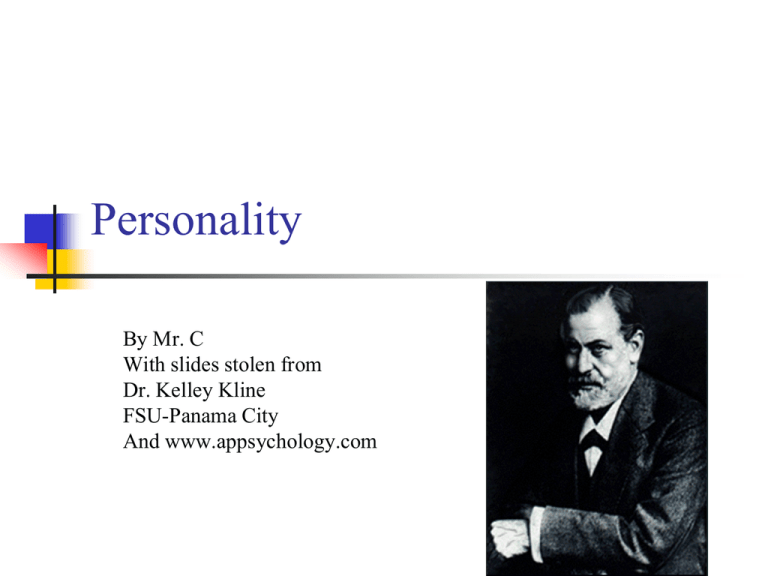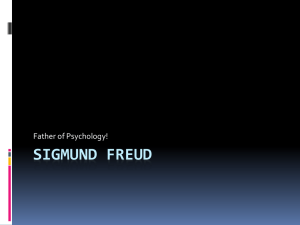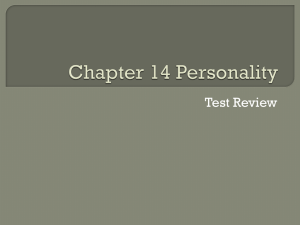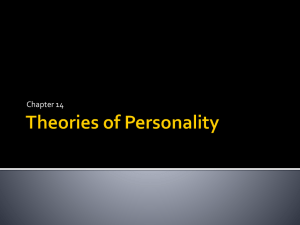
Personality
By Mr. C
With slides stolen from
Dr. Kelley Kline
FSU-Panama City
And www.appsychology.com
Personality Questions (11 nc)
What is personality?
Who was Hippocrates?
What is psychodynamic approach to personality?
Freud’s 3 structures of personality?
What are ego defense mechanisms?
What is repression? Regression?
What is displacement? Projection?
What is reaction formation? Denial?
What is sublimation? What is compensation?
What are psychosexual stages of development? (3
cards)
What is fixation?
Note: Personality will need 21 note cards. You will want
to color them the same color.
Hippocrates
Believed our personality is based on 4
“humours” or bodily fluids (blood,
phlegm, cholera, black bile)
What is the psychodynamic
perspective of personality?
Started by Sigmund Freud, this perspective
believes we are dominated by repressed,
unconscious sexual, biological drives.
Other psychoanalysts include Alfred Adler, Erik Erikson, Carl Jung
I. Freud—1856-1939
An Austrian Neurologist who became
fascinated with studying
hysteria.
Father of psychoanalysis.
The Psychodynamic approach was the
first theory on personality (early 1900s)
We are driven by unconscious
forces (sexual and aggressive
forces).
What is the iceberg analogy of
consciousness?
III. Levels of Consciousness: Iceberg
theory
1. Conscious mind – like the top of the iceberg, only a
small portion of our mind is accessible to us.
2. Preconscious mind – material that is unconscious,
but can be easily brought into awareness. Moves back
& forth easily between conscious & unconscious.
3. Unconscious mind – is completely outside of our
awareness (could produce anxiety if made conscious).
The iceberg is a
good analogy
because very little is
visible on the
surface but lots
more is visible under
water.
IV. What are Freud’s parts of
personality?
1. Id – “pleasure principle” unconscious
impulses that want to be gratified, without
regard to potential punishment.
2. Ego “reality principle” – moderates
between the id and superego.
3. Superego – the “moral principle” of our
personality which tells us right from wrong our
conscience
Which part of our personality is
completely unconscious?
A. Ego
B. Id
C. Superego
D. yomamma
What TV characters are driven
by the ID?
ID
ID leads us to eating and
drinking
How about Superego?
Superego
How about ego, our voice of
reason?
Ego
Id controlling Marge.
The Ego moderates between the
Id and the Superego.
Personality Development
Freud argued that personality developmentis result of conflicts we resolve in
childhood.
We learn to satisfy id impulses while
handling societal pressures.
In Sigmund Freud’s view, the
role of the ego is to
A. make the individual feel superior to
others
B. make the individual feel inferior to others
C. mediate among the id, the superego, and
reality
D. serve the demands of the unconscious
E. serve the demands of the superego
In accord with psychoanalytic
theory, one of the primary
functions of the superego is to
A.assure that desires are gratified at the
appropriate time
B.guide behavior prior to the development
of the id and ego
C.assure immediate gratification of any
need or desire as it occurs
D.balance and respond to the demands of
the id and ego
E.serve as the individual’s conscience
What are ego Defense
Mechanisms?
How our personality (ego)
deals with unpleasant
emotions and thoughts.
VI. Defense mechanisms
1. Repression: “motivated forgetting” the
suppression of unpleasant thoughts. We
push unpleasant thoughts into unconscious
so that we can’t access them.
E.g., a child who is molested, may suppress
the traumatic event so that he/she has no
memory for the event.
2. Rationalization – we justify
something bad we’ve done
You run over a person and tell yourself “I’m
sure he would have died soon anyway.”
You steal and say, “Well, I spend a lot of
money at this store!”
Everybody else is doing it!
New Orleans looting after Katrina
3.Regression
Dealing with problems by “regressing”
or going backward in terms of maturity.
Ex: Soldiers crying for “mommy”
Ex: Fighting couples acting immature.
4. Displacement- you take out your
anger & frustration on a person or object
not the actual target of your anger in a
negative way
E.g., After being grilled by your boss, you
go home & yell at your partner or the
dog/cat.
Peeing on the teacher’s car.
5. Projection – You attribute your
negative characteristics to another person.
When people project their own faults onto
others, they generally do not deny that they
themselves possess those faults.
E.g., Your partner tells you how selfish you
are, when they are in fact selfish.
Why is this projection?
6. Reaction Formation – acting the
opposite of how you feel.
You do the opposite of how you feel to
defend your own doubts.
E.g., A person who doubts his faith may act
like a religious zealot to defend his religion.
Reaction Formation
7. What is Denial?
Denial, not “The Nile!!!!”
2. Denial- refusing to believe something
unpleasant has occurred.
We refuse to accept horrible news, even
with evidence to the contrary.
E.g., you hear a friend has died & won’t
believe it’s true.
“I don’t have drinking problem”
8. Sublimation –Making something bad
about yourself into something positive.
Don’t mix up with displacement (kicking dog)
E.g., Aggressive impulses are transformed into the
urge to engage in competitive sports.
Most desirable way of dealing with unacceptable
id impulses.
9. What is compensation?
We do something well to make up
(compensate) for other deficits in our
life.
Ex: We become a cop to compensate
for getting picked on as a child.
According to Freud, which is the
most important factor in
personality?
A.behavior
B.unconscious impulses
C.thoughts
D.emotions
E.genetics
Hal is fearful of men who are friendly toward
him, convinced that they are all homosexuals
attempting to seduce him. Should it be the
case that Hal is himself a latent homosexual
fearful of admitting this even to himself, we
might conclude that he is using the defense
mechanisms of repression and
A. reaction formation
B. projection
C. displacement
D. regression
E. denial
When parents refuse to accept several
psychologists’ diagnosis of a child’s
mental illness, they are using which of
the following defense mechanisms?
A. Denial
B. Displacement
C. Projection
D. Rationalization
E. Regression
A man who has numerous reasons to hate
his mother instead lavishes her with
unrealistic amounts of attention and love.
He is probably exhibiting the defense
mechanism of
A. regression
B. identification
C. reaction formation
D. displacement
E.projection
Freud’s psychosexual stages
Oral (0-1) (1 card)
Anal (2-3) (1 card)
Phallic (4-5) (1 card)
Latency (6-12) (1 card)
Genital (puberty and older) (1 card)
Each stage has a pleasure center –
center for libidnal energy
Oral Stage
Oral Stage
The pleasure center is the mouth. Freud said
the pleasure center moves around the body
as we develop.
Freud said if we are not gratified at this stage
we will be fixated at this stage.
Adults who are fixated at this stage like to do
things with mouth for pleasure (smoking,
eating, chew gum, bite nails, other things.)
Anal Stage
Anal stage
Adults who were not gratified at this
stage can be anally repulsive or anally
retentive.
Anal retentive are overly-neat and
organized (Type A personality)
Anal repulsive are overly messy and
irresponsible.
Phallic stage
Genitals are the
pleasure zone.
Oedipal complex –
boys have
erotically tinged
preference for
their mother –
compete with their
father for mother’s
attention
Phallic stage cont. . .
Not resolving the Oedipal conflict may
result in boy not identifying with father,
thus not develop a conscience.
Electra complex (girls’ equivalent to
Oedipus)
Also. . . Girls have penis envy and
blame and resent their mothers for their
anatomical deficiency.
The latency period “the cooties stage”
begins sometime around the age of six and
ends when puberty starts to begin. Freud
believed that in this phase the Oedipus
complex was dissolved and set free,
resulting in a relatively conflict-free period of
development. In this phase, the child begins
to make connections to siblings, other
children, and adults. This phase is typified by
a solidifying of the habits that the child
developed in the earlier stages.
Latency – “cooties stage” - sexuality is
hidden (latency = hidden) Children in same
sex groups. Boys hang with father. Girls
with mother.
Genital stage (puberty ++)
Libidinal energy is not focused on your
own genitals (like in the phallic stage)
but on other people’s genitals.
Fixation in earlier stages will hinder this
stage.
According to Freud, what occurs
during the phallic stage?
A. the child struggles with
independence and inferiority
B. the child develops sexual feelings
for the opposite sex parent while
harboring jealousy towards the other
parent
C. the child develops sexual feelings
for the opposite sex during
preadolescence
D.the child becomes fixated on issues
of neatness and rebellion
What is a result of being fixated
at the oral stage?
A.overeating
B.stingy
C.extreme neatness
D.suppression
E.excessive anger
Carlos never cleans up after himself.
He’s disorganized and impulsive.
Freud would say that Carlos is fixated
at the anal stage, which means:
A. His parents did not toilet train him
properly.
B.His parents did not wean him properly
C.He uses defense mechanisms to relieve
anxiety.
D.His progress toward self-actualization is
blocked.
End of part 1.
Your test will cover Freud, level of
consciousness, id, ego, superego,
psychosexual stages, defense
mechanisms, fixation
Personality pt. 2 10 nc
What methods psychoanalysts use?
Pros of psychoanalytic theory?
Cons of psychoanalytic theory?
Who is Carl Jung?
Who is Alfred Adler?
What is Humanistic perspective on personality?
Who is Abraham Maslow?
Who is Carl Rogers?
Projective versus self-report tests?
Examples of personality tests?
VII. Psychoanalysis (psychodynamic):
Unconscious thoughts & emotions are
brought into awareness to be dealt with.
Psychological problems – the result of
unconscious processes.
Bringing unpleasant unconscious thoughts
into to consciousness, produces catharsis.
A. What are Psychoanalytic methods of
therapy (4 of them):
1. Free Association – patient reports
anything that comes to his/her mind.
The psychoanalyst listens for links &
themes that might tie the patient’s
fragmentary thoughts or remarks together.
B. Dream analysis:
Dreams have two types of content:
Manifest content- actual events in dream.
Latent content – hidden message in dream.
Freud thought that each dream represents a
form of wish fulfillment. The wish may be
disguised, but it is always there.
C. Transference
Feelings of love or other emotions (hatred)
are expressed toward the therapist.
These feelings are actually unconsciously
felt toward others; the patient is projecting
these feelings onto the therapist.
This provides clues about the client’s
feelings about these other people.
Hypnosis
Hypnosis is a psychoanalytic therapeutic
technique.
Supposedly reaches into the
subconscious
Criticisms of Freud’s theory:
1. Freud had no scientific data to support his
theories.
2. Freud’s theories (unconscious, libido, etc.)
cannot be observed.
3. Theory explains behavior (post-hoc) after the
fact.
4. Observations not representative of population
(very sexist and not multicultural).
Pros of Freud’s theory
1. Argued that childhood experiences are
important in personality development.
2. Information outside of awareness does
influence us.
3. Defense mechanisms—good descriptions
of some of our behaviors.
One criticism of Freud’s
psychosexual theory of
development is that it
A.emphasizes developmental changes
in the oral and anal stages
B.views adult disorders as
adjustments to the environment
C.views fear of loss as a motivating
drive
D. is based on empirically unverifiable
constructs
E. is based on ethnographic studies
Which is a criticism of Freud’s
psychodynamic approach to
personality?
A. His sample of patients was small and
unrepresentative of the general
population.
B. His theory reflects Western European
and N. American cultural values
C. The theory was not developed
scientifically and thus is subject to bias.
D. The theory was not comprehensive
and has had little influence on
psychology.
More psychoanalysts
Who was Carl Jung? He was a
psychoanalyst who disagreed with
Freud.
There are 2 things you need
to know about him.
Carl Jung
Less emphasis on social
factors.
Focused on the
unconscious.
We all have a
collective
unconscious: a
shared/inherited well of
memory traces from our
species history.
Carl Jung
Archetypes – certain symbols/literary
characters that we all recognize
Ex: wise old man, witches, messiah
Alfred Adler
Childhood is important to
personality.
But focus should be on
social factors- not sexual
ones.
Our behavior is driven by
our efforts to conquer
inferiority and feel
superior.
Inferiority Complex
We strive to be superior
Coined term compensation
First to study birth order
Humanistic Psychology
In the 1960’s people
became sick of Freud’s
negativity and trait
psychology’s objectivity.
•Along came psychologists
wanted to focus on “healthy”
people and how to help them
strive to “be all that they can
be”. Freud studied the ill, Humanists studied the well.
Abraham Maslow’s Self
Actualizing Person
Hierarchy of Needs
•Ultimately seek selfactualization (the
process of fulfilling our
potential).
•Maslow developed
his ideas by studying
what he termed
“healthy people”.
Who did Maslow study?
Self-Actualized People
They share certain characteristics:
•They are self aware and self accepting
•Open and spontaneous
•Loving and caring
•Not paralyzed by others’ opinions.
•They are secure in who they are.
Self-Actualized People
Problem centered rather than self-centered.
Focused their energies on a particular task.
Few deep relationships, rather than many
superficial ones.
Self-Actualization
These are the qualities that
make up a mature adult.
•These people have found their
calling in life.
Is this a goal worth striving
for?
Carl Rogers
Congruency – our ideal self needs to
match our actual self for us to be a fully
functioning person.
We have free will
We need unconditional positive regard
from our therapist.
Rogers believes that all creatures strive to
make the very best of their existence
If they fail to do so, it is not for a lack of
desire!
Carl Rogers- humanist believed we have free
will, we need unconditional positive regard,
need congruence between our ideal and
actual self.
CARL ROGERS
A. Actualizing tendency (humans
tendency to fulfill his/her human potential)
-Rogers believe we are innately positive
-As we grow up, parents and authority
figures place “conditions” on our worth
e.g. Spanglish
-We begin to operate under conditioned
positive regard
-By acting according to other people’s
standards, we lose our sense of self
B. Self concept (two parts)
1. Real self
-The you that you are
2. Ideal self
-The self we think we should be (unattainable)
e.g. You are not a quality person if you don’t have
a girlfriend…social situations will be threatening
e.g. Successful people go to college…career options
outside of this will be denied
IV.
Goal: Fully functioning Individual (congruency)
Uniting your real and ideal self
REAL
IDEAL
Incongruent self: neurosis
REAL
IDEAL
Incongruent self: psychosis (shattered self)
Fully-Functioning Individual
Congruence!
Open to experiences
Freedom from society
Creativity
Person-Centered Therapy
(Client-centered or Rogerian)
Show the client unconditional positive regard:
accepting and valuing self (and people) regardless
of their behavior
Allow the client to take responsibility for his life
Mirror the clients emotions and thoughts so that
he/she can decide their path in life
Be congruent (honest, genuine, vulnerable)
Show empathy
How do we measure personality?
(examples of personality tests?)
Projective tests ask subject to interpret
a picture. Used only by psychoanalysts;
are subjective. Ex. TAT, Rorschach Ink
blot test
Self-report tests are questionnaires.
Used by humanists and others. Used
more commonly than projective. They
rely on honesty. Ex: Five factor, MMPI,
Myers-Briggs.
TAT
Thematic Apperception Test
A projective test which people
express their inner feelings through
stories they make about ambiguous
scenes
Thematic Apperception Test
TAT
Rorschach Inkblot Test
The most widely used projective
test
•A set of ten inkblots designed to
identify people’s feelings when
they are asked to interpret what
they see in the inkblots.
Rorschach Inkblot Test
Rorschach Inkblot Test
Rorschach Inkblot Test
Rorschach Inkblot Test
What is the trait approach to
personality?
A trait The typical way a person
perceives, feels, believes or acts.
Example: introverted, thinker, feeler,
uptight
The trait approach says a personality is
the sum of all the traits.
Problem: traits are situational, not
permanent.
What is Myers-Briggs personality
type?
There are 16 different personality
types.
Ex: INTP (Introverted, iNtuitive,
Thinker, Perciever)
ESFJ – Extroverted, Sensor, Feeler,
Judger
Virtually all trait models, and even
ancient Greek philosophy, include
extraversion vs. introversion as a
central dimension of human personality.
Another prominent trait that is found in
nearly all models is Neuroticism, or
emotional instability.
Five Factor Model (modern)
Tests our personality by measuring a
person’s level of extroversion,
agreeableness, conscientiousness,
emotional stability-instability, and
openness to experience.
Similar to the Meyers-Briggs.
Are 5 traits enough?
The MMPI
The most common test today is the
Minnesota Multiphasic Personality
Inventory.
What is locus of control?
Locus means “place” in Greek (loci is
plural)
refers to a person's belief about what
causes the good or bad results in his
life, either in general or in a specific
area
External locus of control?
Having an external locus of control
means the cause of everything comes
from the outside.
In a car accident, the car hit you or the
roads were slippery.
Acing a test – the teacher likes you.
You are lucky.
Internal locus of control
Having an internal locus of control –
you believe you are the cause and
solution to problems. You deserve
credit.
Crash a car? “I wasn’t paying
attention”
Ace a test? I studied. I copied my
notes onto note cards.
Samantha has been acting out in school.
She gets into fights and is failing many
of her classes. Her parents are in the
middle of a divorce and she is shuttling
between their houses. What is each of
these? How would each of the following
apply to her behavior?
a). id b.) locus of control c.) trait
theory d.) displacement e.)
humanistic theory
Chapter 12 Quiz
Personality
1. Adam loved his girlfriend who dumped
him, but acts as if he’s glad to be rid
of her. His behavior most clearly
illustrates which of the following
Freudian defense mechanisms?
a.
b.
c.
d.
Repression
Projection
Reaction formation
Sublimation
2. Which Freudian personality system is
guided by the reality principle?
a.
b.
c.
d.
Id
Ego
Unconscious
Superego
3. In contrast to the blank slate (tabula
rasa) view of human nature held by the
behaviorists, humanists believe humans
are born
a. Evil and instinctively selfish
b. Good and with an inner drive to reach our
full potential
c. Neutral and that personality is based on our
perceptions of reality
d. Weak and need others to find a meaning
and purpose
4. One personality trait that is thought to
be highly heritable is:
a) generosity
b) sense of humor
c) inhibition
d) diligence
5. Bertha is tall, thin, and frail. She enjoys
studying and reading science fiction novels.
She prefers to be alone rather than in a large
group. According to Sheldon’s somatotype
theory of personality, she is
a.
b.
c.
d.
e.
An endomorph
An ectomorph
A mesomorph
An extrovert
An introvert
6. The most commonly used personality
assessments are
a.
b.
c.
d.
Projective tests
Naturalistic observations
Structured interviews
Self-report inventories
7. Adler would not have agreed with the
importance of which of the following
ideas?
a.
b.
c.
d.
Birth order
Styles of life
Striving for superiority
Womb envy
8. Roberto believes that he is the master of
his ship and in charge of his destiny.
According to Rotter’s theory of
personality, Roberto has
a. An external orientation to the world about
him
b. An internal locus of control
c. An extraverted personality
d. A low sense of self-efficacy
9. Mother Theresa’s altruism showed in
everything she did. According to
Allport’s trait theory, Mother Theresa’s
altruism was
a. A common trait she shared with most other
religious people
b. A cardinal trait
c. One of several central traits that
characterized her exceptional life
d. Basically inherited from her father
10. Which is NOT one of the big five
personality traits?
a) honesty
b) extraversion
c) openness
d) agreeableness
11. The order of stages in psychosexual
development is
a.
b.
c.
d.
Anal, oral, phallic, genital, latency
Oral, anal, latency, phallic, genital
Oral, anal, phallic, latency, genital
Anal, oral, genital, latency, phallic
12. What need was Abraham Maslow
expressing when he said that “what a
man can be, he must be?”
a.
b.
c.
d.
The need for superiority
The need for unconditional love
The need to self-actualize
The need to achieve
13. According to Rogers, troublesome
anxiety is caused by
a.
b.
c.
d.
Unresolved sexual conflicts
Unconditional love
Threats to our self-concept
The use of defense mechanisms
14. American parents are LEAST likely to
teach their children to
a.
b.
c.
d.
Be self-reliant
Feel good about themselves
View themselves as special individuals
Be modest about their personal
accomplishments
15. Dr. Li asks her clients to interpret
ambiguous pictures of people in
various settings. The method she is
using is called the
a) Rorschach test
b) MMPI
c) WISC
d) TAT
Chapter 12 Answer Key
1. C
2. B
3. B
4. C
5. B
6. D
7. D
8. B
9. B
10. A
11.
12.
13.
14.
15.
C
C
C
D
D
Essay Question Possibilities!!
One of the following essay questions
will appear on your test, be familiar
with all of them!!
Essay Question # 1
Psychodynamic theories have been
criticized for their lack of empirical
evidence and poor testability. Are there
some of Freud’s, Jung’s, and Adler’s
ideas that would be easier to test than
others? How might you go about
designing research studies to test some
of these ideas?
Essay Question # 2
How do you think an operant theorist
like Skinner would explain defense
mechanisms? Give several examples.
Essay Question # 3
On first learning about the different
theoretical perspectives on personality,
many people like the views of the
humanistic theorists best. Why do you
think this is? Are these reasons sound,
scientific criteria for evaluation a
theoretical perspective on personality?
Essay Question # 4
Modern personality research tends to
focus on specific traits. Psychologists
have moved away from attempting to
develop “grand theories” of personality
such as those of the psychodynamic
and humanistic theorists. Why do you
think this has occurred? Do you think
the trend toward “mini-theories” that
focus on specific personality traits is the
best way to advance our understanding
Essay Question # 5
Discuss ways in which each of the
major perspectives on personality has
influence some aspect of everyday life
in modern society.
Good Luck!
Make sure to double check all of your
answers and study them for the
upcoming exam. Remember, AT LEAST
FIVE of the questions from this quiz will
make some sort of appearance on the
chapter test along with one of the essay
questions.
Take advantage of this study guide and
good luck on your test!










